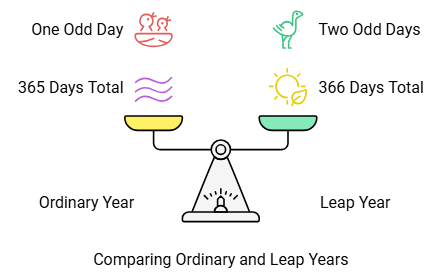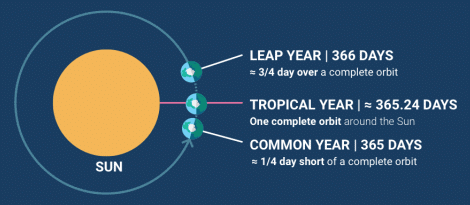Introduction to Calendar | Quantitative Techniques for CLAT PDF Download
Calendar
A calendar is a system of organizing units of time for the purpose of reckoning time over extended periods. By convention, the day is the smallest calendrical unit of time; the measurement of fractions of a day is classified as timekeeping.

- Ordinary year: An year having 365 days is called ordinary years.
- Leap year: Year having 366 days is called a leap year. Every leap year is exactly divisible by 4 and ordinary years are not completely divisible by 4.
- Odd days: In a given period, the days apart from complete weeks are called odd days. An ordinary year has one odd day, i.e. 365/7 = 52 weeks + 1 day While the leap year has two odd days, i.e. 366/7 = 52 + 2 days.

To Find the Number of Odd Days
- In 100 years there are 24 leap years + 76 ordinary years
= 24 x 52 weeks + 24 x 2 days + 76 x 52 weeks + 76 days
= 6 days + 6 days
= 12 days = 1 week and 5 days
So, in 100 years there are 5 odd days similarly in 200 years there are 3 odd days and in 300 years there is 1 odd day in 400 years there is 0 odd day similarly in 800 years, 1200 years and 1600 years there is 0 odd day. - Odd days in Feb: In an ordinary year, Feb has no odd day, whereas in a leap year Feb has one odd day.
- 1st day of the century must be Tuesday, Thursday or Saturday and Last day of a century cannot be Tuesday, Thursday or Saturday.
To Find a Particular Day When a Day and a Date is Given
Step I: Find out the number of odd days between the given date and the date for which the day is to be found one.
Step II: From the given day count the odd days in the forward direction to arrive at the day on the given date.
Example 1: If 10th January 1992 was Saturday, what day of the week was on 6th March 1993.
Solution:
Here’s a step-by-step way to find the day:
From 10 Jan 1992 to 10 Jan 1993 is one full year.
– 1992 was a leap year, so that span is 366 days.From 10 Jan 1993 to 6 Mar 1993:
– Jan 11–31 Jan: 21 days
– Feb 1993 (non-leap): 28 days
– 1–6 Mar: 6 days
Total = 21 + 28 + 6 = 55 daysTotal days advanced from 10 Jan 1992 to 6 Mar 1993 = 366 + 55 = 421 days
Find 421 mod 7 to see how many weekdays we move forward:
421 ÷ 7 = 60 weeks + 1 day ⇒ remainder 1Starting from Saturday, moving ahead by 1 day gives Sunday.
Answer: 6 March 1993 was a Sunday.
Example 2: On April 4, 1988, it was Monday. What day of the week was on 5th Nov. 1987.
Solutions: No. of days between 5th Nov. 1987 to 4th April 1988 6th Nov 1987 to 30 Nov = 25 days
Dec 1987 = 31 days
Jan 1988 = 31 days
Feb 1988 = 29 days
March 1988 = 31 days
4th April 1988 = 4 days
Total = 151 days
No. of odd days = 151 / 7 = 21 weeks – 4 days
So, since 5th Nov. 1987 is prior to 4th April 1988
We are to count 4 days backwards from Monday, the required day is Thursday.
To Find the Day on a Particular Date if Day and Date is not Given
- The procedure can be understood from the given example.
Example 3: Find the day of the week on 26th Jan. 1960.
Solution:
Here’s a step-by-step way to find the weekday of 26 January 1960:
Anchor date: 26 January 1950 was a Thursday (the first Republic Day)
Span to 1960: From 26 Jan 1950 up to 26 Jan 1960 is exactly 10 years.
Count leap years between: 1950–1959 includes the leap years 1952 and 1956 → 2 leap years
Total days advanced:
Non-leap years: 10 – 2 = 8 years × 365 days = 2920 days
Leap years: 2 × 366 = 732 days
Sum = 2 920 + 732 = 3652 days
Reduce mod 7:
3652 ÷ 7 = 521 weeks + 5 days ⇒ remainder 5
So from Thursday we move forward 5 weekdays.Shift Thursday by 5 days:
+1 → Friday
+2 → Saturday
+3 → Sunday
+4 → Monday
+5 → Tuesday
Answer: 26 January 1960 fell on a Tuesday.
Miscellaneous Examples
1. On which day of the week did India celebrate its first Republic Day on January 26, 1950?
(a) Thursday
(b) Friday
(c) Sunday
(d) Tuesday
Answer : (a) Thursday
1. Split the year into century and year-within-century
• Century = 1900s → century‐code = 0 odd-days
• Year-within-century = 502. Compute odd-days contributed by the year-within-century
Take the last two digits: 50
Divide by 4 (to count leap years): ⌊50⁄4⌋ = 12
Sum: 50 + 12 = 62 → 62 mod 7 = 62 – 56 = 6 odd-days
3. Month-code for January in a non-leap year
January → 0 odd-days4. Date contribution
26 → 26 mod 7 = 26 – 21 = 5 odd-days5. Total odd-days
century (0) + year (6) + month (0) + date (5) = 11
11 mod 7 = 11 – 7 = 4 odd-days6. Map odd-days to weekdays (taking Sunday = 0)
0 → Sunday
1 → Monday
2 → Tuesday
3 → Wednesday
4 → Thursday
5 → Friday
6 → Saturday
4 ⇒ Thursday
2. What is the day on 15th August 2050?
(a) Saturday
(b) Monday
(c) Wednesday
(d) Tuesday
Answer: (b) Monday
15th August, 200 = (2049 years + Period from 1st January 2050 to 15th August 2050)
Odd days in 1600 years = 0
Odd days in 400 years = 049 years = (12 leap years + 37 ordinary years) = (12 × 2 + 37 × 1) = 61 odd days = 5 odd days
Odd days in the year 2050 =
January = 3, February = 0, March = 3, April = 2, May = 3, June = 2, July = 3, August = 1Total odd days in 2050 till 15th August = 3 + 0 + 3 + 2 + 3 + 2 + 3 + 1 = 17 odd days or 3 odd days
Total odd days = 5 + 3 = 8 odd days or 1 odd day.
Days corresponding to odd-day counts:
0 odd days = Sunday
1 odd day = Monday
2 odd days = Tuesday
3 odd days = Wednesday
4 odd days = Thursday
5 odd days = Friday
6 odd days = SaturdayTherefore, it will be Monday on 15th August 2050.
Hence, Monday is correct.
3. How many odd days are there in 100 years?
(a) 0
(b) 1
(c) 5
(d) 3
Answer 3: (c) 5
In 100 years there are 24 leap years and the 100th year itself is not a leap year.
So the number of ordinary years = 76 years.Total odd days in a leap year = 2, so in 24 leap years = 48 odd days.
Total odd days in an ordinary year = 1, so in 76 ordinary years = 76 odd days.Total odd days = 48 + 76 = 124 odd days = 17 weeks and 5 odd days.
Hence, the correct answer is 5.
|
51 videos|172 docs|73 tests
|
FAQs on Introduction to Calendar - Quantitative Techniques for CLAT
| 1. What are odd days and how do you calculate them? |  |
| 2. How can you determine the day of the week for a given date? |  |
| 3. What steps do you take to find the day of the week for a specific date without having a reference day? |  |
| 4. Can you explain the concept of leap years and their impact on the calendar? |  |
| 5. What are some common practical applications of understanding calendars and odd days in exams? |  |






















